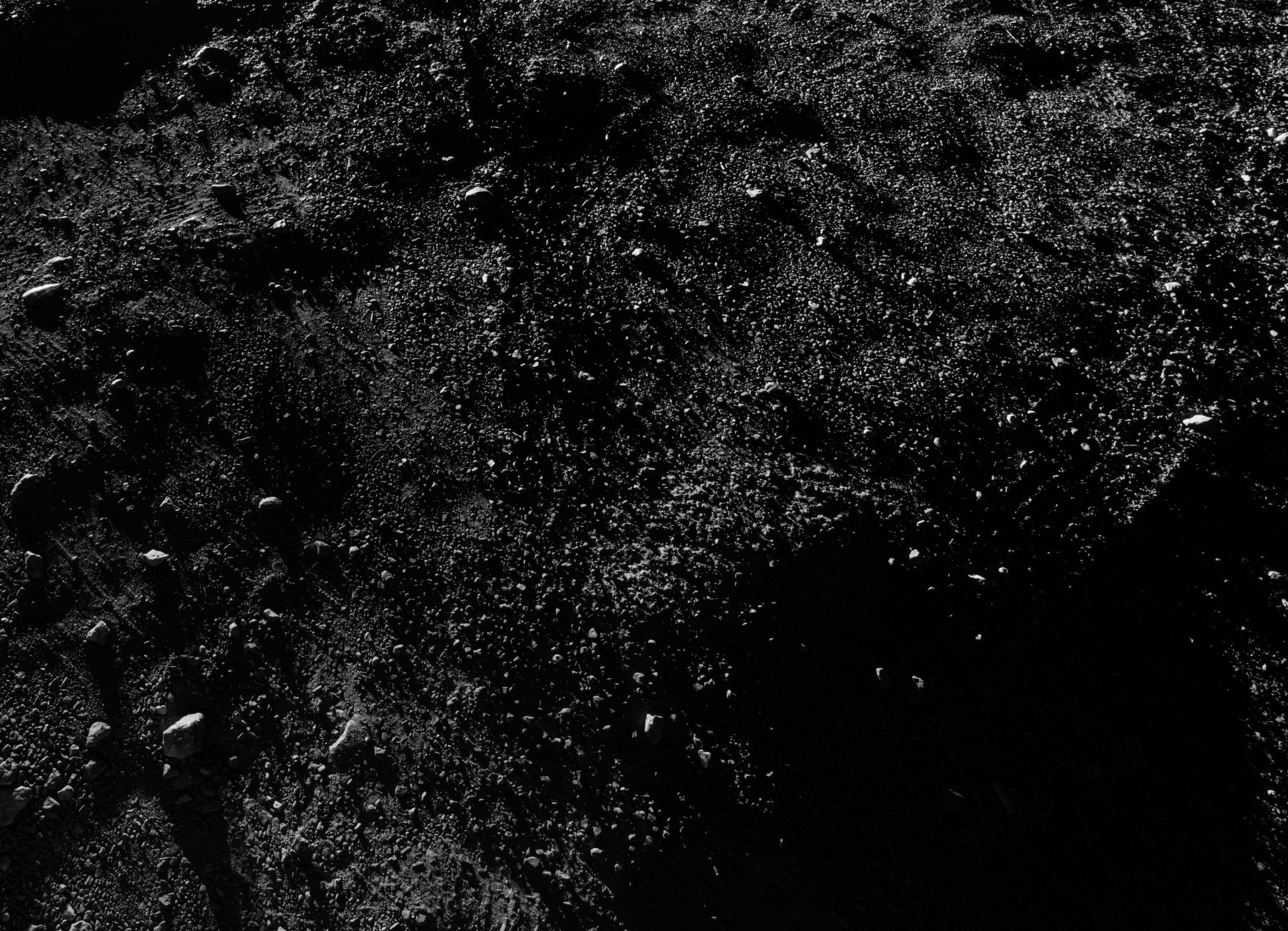Every few months, when the spirit moves us or just when we find ourselves in the neighborhood, we like to go visit the dirt. Sometimes this doesn't work—if the person that sits behind the desk is taking lunch, which generally happens between 3:00 and 3:30 but stretched to 3:40 when we went by last week, for example. Or, if there isn't enough time. Or, if the desire to escape the gaudy-giddy luxury crush of the neighborhood becomes so urgent that it overrides the wish to visit what is one of my favorite places in New York City and sends me weaving like a punt returner through clots of slow-moving pedestrians and their shopping bags and toward the subway. But one thing that I am confident in saying about Walter De Maria's installation New York Earth Room, which has been open to the public on the second floor of a residential building at 141 Wooster Street since 1980, is that it works.
It's the third such installation that De Maria made, although the other two—one opened in Munich in 1968 and another at the Hessiches Landesmuseum in Darmstadt, Germany in 1974—don't exist anymore. This one sits at the top of a very narrow staircase in a Soho loft building. There's a Marc Jacobs store at the downtown end of the block and an outpost of the global art gallery Hauser & Wirth across the street, too, although when my wife and I visited the Earth Room last week, that gallery was closed. A big-league outfielder could walk out the front of 141 Wooster Street, treat himself to a crow-hop, and throw a baseball through the window of the Apple Store located several hundred feet to the southwest, provided that the extremely valuable real estate between those two were removed. The floors above The Earth Room all have people living and working on them, in what real estate types describe on real estate sites as "quiet, large, quintessential Soho loft[s]." This one, on the sixth floor, sold for $2.7 million last year. But if you buzz up to the second floor, a person sitting behind a desk will let you into the building, and you will climb those stairs and enter a living space filled nearly to the windowsills with dark dirt.
The installation itself is, in the most basic sense, the fulfillment of some instructions from the artist: 250 cubic yards of earth are distributed across 3,600 square feet of floor space at a depth of 22 inches, creating what De Maria described as "a minimal horizontal interior earth sculpture" that weighs 280,000 pounds. (De Maria collaborated on the installation with the architect Richard Gluckman.) A pane of glass just slightly taller than the dirt separates the Earth Room from the viewing area, which on Wooster Street is a little alcove space in which two people can stand comfortably and three can stand uncomfortably. That is more or less what it is; the more difficult part to describe is why visiting it makes my brain feel as if it has just had a cool drink of water.
In the absence of any expertise or a more informed framework, "it works for me" or "it doesn't work for me" is how I tend to think about art. As with music, this is a language I can only sort of comprehend and absolutely cannot speak myself. If something works for me, I feel the sense of it working in an unambiguous and more or less unreasoning way. That sense, much more so than the Earth Room itself, is a difficult thing to describe.
When De Maria first showed it in New York, in 1977, the piece was listed as "for sale," provided that any future installation maintained the artist's specified cubic yardage of dirt; other iterations could offer two or more viewing areas, "providing that, if more than one room is used, the earth flows contiguously throughout the space used." It has changed somewhat over the years, and needed to be topped off with new dirt in 2022; its former caretaker, who was behind the desk for 34 years, told the New Yorker in 2023 that he attributed this to the weight of his walking on it and visitors sneaking out with the occasional handful as a souvenir. (De Maria requested that visitors not take photos, and despite the fact that I would absolutely buy a T-shirt with the words EARTH ROOM on it, there is no gift shop.) The most dramatic change to the space was the addition of an HVAC system in 2023, which addressed longstanding issues of moisture and mold but, Artforum observed, "has greatly diminished its once-pungent scent." There is a good deal of work involved in keeping the room the way it is, even beyond the watering and the raking required to keep the surface uniform. That Artforum story notes that mushrooms still grow in the Earth Room, and caretakers still cull them. There's something alive in there.

The day of our most recent visit to the Earth Room was the hottest of the year to that point. This is not a record that any day gets to hold for very long anymore, but this one was memorably low, dense, and close, and it awakened the city's summer smells. I've lived here for nearly 25 years and these still surprise me, the sudden efflorescence of some lurid waft suggesting something fermenting painfully somewhere just out of view, the invisible columns of air redolent with what I guess is the smell of poaching sewage, the stubborn puddles blooming with algae days after the last rainfall. The smells all suggest, some more urgently than others, something under the streets that is not working properly, or at all.
This is not what I or anyone else loves about living here, but as the surfaces of neighborhoods like Soho buff and blur into luxe uniformity the rudeness of those smells can seem like proof of life. There are blocks where the storefronts seem to be looping like the backgrounds in old cartoons; walk a mile and the same wan and pricey tastefulness scrolls carelessly behind you. There are also blocks where expensively dressed young people wait to enter stores that seem to have almost nothing for sale; security, sometimes in formal dress, wear earpieces and sunglasses, as if they were Secret Service agents protecting the few mannequins within. On this last visit, my wife noticed storefronts for brands that she'd assumed existed only on her Instagram timeline.
There was once a lot of art being made and performed in this part of Lower Manhattan, because there was once a lot of space there where artists could afford to live and work. There are still some galleries, big and small, and some of the artists stayed and through their stubbornness or good fortune found that the spaces once abandoned to them are now extremely valuable. But it is decidedly no longer a place where a person can afford to live while figuring stuff out; the people that work there get on the train when their workday is over and go someplace else. You get the sense, in neighborhoods like this, that things are pretty much filled in, that even the empty storefronts are in some way spoken for and that what look like empty apartments are all already owned—by someone who can afford to be there only some of the time, or by the terrible nephew of some foreign mining magnate who is never there at all. This is true of the whole city, and to some extent of every city.
The works that De Maria made after the Earth Room were not in cities. The pieces were getting bigger in their scale and their implications; he needed more space. Those works are still out there, in the deserts of California and Nevada and New Mexico, either in the landscape or becoming part of it along the grander time-scales that apply in spaces like those; when De Maria's Lightning Field, in Western New Mexico, is lit up by that night's desert lightning, it is also just kind of being where it is, as nature happens to it. It's a kind of collaboration, but it is also, in the way that art always is, an invitation. The work only looks static—it needs to be maintained, but it also needs to be observed and experienced to be completed. People will bring something to it, beginning but not ending with their presence and attention, that closes the circuit and brings it to life.
The reason that people who hate cities always describe them as dying or being killed or already dead—“nobody lives there except the criminals,” Donald Trump said earlier this month, “you can’t survive”—is because they do not like that they are alive in the first place. There is a sense of possibility inherent in that aliveness, and it is fundamentally opposed to the order that those people and their institutions are forever trying to impose on the things they aim to Take Back. I like to be surprised, and I like finding things where they are not supposed to be; making 280,000 pounds of weird wet earth at home in a walk-up apartment building more than qualifies, there. I also like—more than that, I depend upon—the idea that those out-of-place things can resist every force working to bring them to heel or make them impossible or just make them make sense, and that they might endure not despite but because of their strangeness, their uselessness, their simple defiant vitality. I love visiting the Earth Room because it is a piece of art that makes me feel something, but it is also important to me to be able to ring a buzzer and be admitted into a space like that. I need to believe that there are things going on upstairs that I do not know about, and could not imagine. I need to be reminded that it is true.
And so, on the hottest day of the summer to that point, our faces were briefly mirrored back at us in a little screen and then the front door clicked and we went in. We went through a fire door and up the little staircase, the steps bowed and grooved in the way old steps get. The room was quiet and the light through the windows was the color of skim milk. The earth looked black in the middle where the light failed, and brighter as it trailed through what might have been a bedroom. We stood and breathed some slightly altered air; there was not the feeling, which you can get for instance in very old churches, of having left the city in some profound way, but we were also very much not where we had been. I held my hand out over the surface of the dirt, and the air above it was cooler, different. It rose like the breath of something sleeping, and we stood there in it until we'd gotten enough, and then we gave the space to whoever needed it next.






